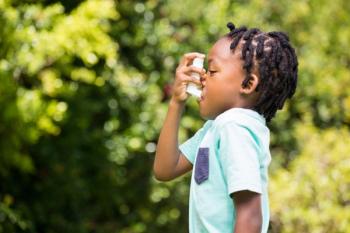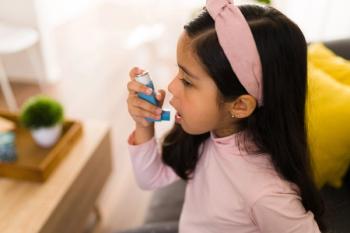
- Consultant for Pediatricians Vol 6 No 12
- Volume 6
- Issue 12
Choking
ABSTRACT: Young children with suspected foreign-body aspirations are common in emergency departments and primary care offices. A "sentinel event" consisting of a sudden onset of choking, gasping, gagging, wheezing, stridor, difficulty in breathing, change in phonation, or difficulty in swallowing may indicate aspiration. In many cases, the diagnosis is missed because the child is asymptomatic on presentation. Normal physical findings can be misleading or the child may have nonspecific symptoms that are initially misdiagnosed as asthma, croup, bronchitis, or pneumonia. Except for endoscopy, most routine diagnostic studies can be falsely reassuring when results are normal. The literature is reviewed here and recommendations are made about how to evaluate and safely manage children with suspected foreign-body aspiration.
An 11-month-old girl was brought to the emergency department (ED) by her parents after a brief choking episode that occurred while the child was crawling on a carpeted floor at home. The episode lasted less than a minute; there was no cyanosis, loss of consciousness, or vomiting. The child subsequently appeared healthy; nevertheless, her parents sought medical care.
In the ED, the child was not in distress; her vital signs (including respiration rate and room air pulse oximetry readings) were normal, as was auscultation of the lung fields.
Radiographic studies were ordered for this child based on the abruptness of the episode and the fact that she had been crawling on the floor when it occurred. Expiratory and decubitus chest films were obtained: these showed no abnormalities (Figure 1). A lateral neck film was also obtained (Figure 2).
A close review of the lateral films suggested the presence of a round soft tissue density just below the true vocal cords. A pediatric otorhinolaryngologist was called to evaluate the child in the ED. After examining the child and discussing the radiographs with the radiologist, it was decided that everything was normal. The parents were reassured that their child was well, and signed her out of the ED--against medical advice.
Approximately 12 hours later, the child began to experience a hacking cough and low-grade fever. Her parents took her back to the ED, where she underwent direct laryngoscopy in the operating room. A cocklebur was identified in a subglottic position and removed.
There are at least 6 distinct species of cocklebur found in the United States. Cockleburs are the seedpods of the Xanthium species. The pods are approximately 5 mm in diameter with multiple "Velcro-like" spines. These spines stick to animals, who spread the seeds. Cockleburs contain carboxyatractyloside, a glycoside toxin that can cause hypoglycemia and hepatotoxicity in humans and farm animals when ingested.
Fortunately, this patient had no systemic toxic effects because the seed casing was intact and had not been ingested.
The patient tolerated the laryngoscopy well and had no further symptoms.
The case presented here illustrates the importance of close evaluation of all children with self-limited choking episodes. Although deaths from foreign bodies in the airway have decreased with better understanding and diagnostic modalities, approximately 150 children in this country die each year of an aspirated foreign body. This represents approximately 40% of all accidental deaths in children younger than 1 year.2 Deaths of boys outnumber those of girls by 2:1; the highest incidence of aspiration is in boys aged 9 and 24 months. The risk of aspiration remains throughout childhood, with a second small spike in boys just before puberty.3
Airway foreign bodies can be difficult to detect in children because symptoms may be minimal or of short duration. The literature contains multiple cases in which the airways accommodate a foreign body such that it causes minimal or no symptoms.
Here I review the evaluation and management of choking episodes in children.
Phases of Choking
Pediatric airways respond to an aspirated foreign body in 3 specific phases:
•Phase 1--the choking episode--can be as brief as a few seconds or it may be prolonged. Not all episodes are witnessed, which makes the diagnosis more difficult. Wiseman4 reviewed the cases of 157 children with foreign-body aspirations and found that diagnosis was delayed in 78% of those in whom a choking episode had not been witnessed.
•Phase 2--the silent phase--entails a period of airway accommodation following the choking episode. The cough reflex abates, and the child may appear normal.5 If the foreign body is partially obstructing an airway, expiratory films and decubitus films may show evidence of air trapping. Atelectasis may be visualized if the foreign body fully occludes the airway. Otherwise, radiographs obtained during this phase are normal, except for those that show radiographically opaque foreign bodies. This phase can last from hours to years.6
•Phase 3 reflects the local inflammatory reaction that the foreign body eventually elicits; this results in airway edema and leads to infection. In rare cases, the only symptom may be a persistent cough, which may be wrongly attributed to other causes of chronic cough, such as asthma.
Children aspirate a wide variety of objects, including pins, toy parts (eg, Lego blocks),7 insects, crayons, teeth,8 acrylic fingernails,9 leeches,10 and cockleburs. Balloons appear to be particularly dangerous airway foreign bodies.11 The most commonly aspirated foreign bodies in young children are radiolucent vegetable matter (usually food). Coins are the most common digestive tract foreign bodies.12,13
Approximately two thirds of all airway foreign bodies in children lodge in the main bronchus; most of the remaining third become lodged more distally. Some studies have shown a propensity for foreign bodies to lodge on the right side, varying from 95%,14 to a slight predominance,1 to no predilection.15 Fewer than 5% of foreign bodies are found in the neck.1
The trachea is the least common site of obstruction and the most difficult site at which to detect an aspirated foreign body. The presentations are often atypical, and the patient has minimal symptoms and few, if any, physical findings. Consequently, there are significant delays in making the diagnosis.16,17 Lateral neck films are debated in the literature as having marginal value in children who have had a sentinel choking episode. Most airway foreign bodies are radiolucent; therefore, a normal film cannot rule out this diagnosis. Nevertheless, a lateral neck film can be rapidly obtained and may provide valuable clues. The case presented here clearly shows that even radiolucent foreign bodies may be visible if highlighted by surrounding air.
The Workup
The usual approach to a child who has had a sentinel choking episode is to take a good history and conduct a thorough physical examination. But how well does this approach hold up in cases cited in the medical literature?
The history. The best way to make any diagnosis is by taking a history. Any sudden episode of choking, gagging, or coughing while feeding or while a small child is playing on the floor raises the possibility of an aspirated foreign body. While children younger than 6 months are unlikely to manage the grasp and coordination necessary to put a foreign object in their mouth, older siblings are often "helpful" in this regard.
Physical examination. Physical findings are of limited value. While the presence of cough, wheezing, stridor, or diminished breath sounds is suggestive, their absence does not rule out a retained foreign body. In addition, these same symptoms can be misattributed to other causes (such as asthma or pneumonia).
Chest films. Films that show radiographically opaque objects or air trapping are helpful, but negative studies do not exclude a foreign body. White and colleagues18 reviewed pediatric foreign-body aspirations reported by the University of North Carolina department of otolaryngology. The vast majority of foreign bodies were organic material; only 15% were radiographically opaque.
A 1996 review advocated chest radiographs with scant supporting evidence.12 That review also discussed airway fluoroscopy, CT, and MRI. In a separate review of air- way foreign bodies, Hoeve and colleagues19 wrote, "We conclude that the diagnosis of foreign-body aspiration is too often missed, and that, apart from bronchoscopy, diagnostic tools are of little value."
Neck radiographs. Lateral neck radiographs are not routinely mentioned in review articles of pediatric airway foreign bodies.5-7,14 One study of foreign bodies lodged in the throat in adults concluded that routine use of neck radiographs was inappropriate because of the low diagnostic yield.20 Despite those cases--such as the one presented here, in which lateral films were helpful--a normal film does not rule out a retained foreign body.
Bronchoscopy. Many authors stress the importance of bronchoscopy as the diagnostic gold standard. In a review of aerodigestive foreign bodies, Reilly and associates12 wrote, "The correct diagnosis can best be attained by direct endoscopic evaluation of the aerodigestive tract, but this is not practical or cost-effective for the millions of children who choke when eating at home or at restaurants. Physicians have the responsibility and the right to determine when bronchoscopy, esophagoscopy, or both should be performed. When the child's diagnosis is unclear, or when symptoms are unexplained, then direct examination by bronchoscopy, esophagoscopy, or both is necessary."
Guidelines from the American College of Chest Physicians state that "in pediatric patients, any acute or persistent cough should raise the index of suspicion regarding the possibility of an airway foreign body. Unless an obvious cause for the cough is readily discernible, bronchoscopic examination is recommended."21
When is it appropriate to pursue bronchoscopy? Some reviews, such as one by Messner,22 include algorithms that advocate releasing the child with follow-up if the physical findings and plain films are normal. This article also states that "in most cases" the child will present with "a history of paroxysmal coughing, followed by wheezing and/or decreased air entry and a persistent cough." However, many authors of case reports and reviews discuss patients with aspirated foreign bodies who are asymptomatic on presentation and who have normal chest radiographs.12 Much of the literature describes patients who were symptomatic at presentation and in whom asthma, croup, or pneumonia was initially diagnosed.7 Cohen and coworkers23 demonstrated that 20% of children with an aspirated foreign body were treated for other diseases for more than a month before undergoing bronchoscopy and foreign-body retrieval. Friedman and Lovejoy24 reported that "20% of patients with an aspirated foreign body have a negative history and a negative radiographic workup." Yamamoto and coworkers25 discussed the same problem with making this diagnosis in their 18-year review.
Based on these studies, it would seem prudent to pursue endoscopic evaluation in any child with a significant history of a sudden onset "sentinel event" of choking, gagging, gasping, or difficulty with breathing when another diagnosis cannot be clearly established. Furthermore, it seems prudent to explore the history and pursue additional radiographic evaluations in any child in whom asthma, croup, bronchitis, or pneumonia has been diagnosed to exclude a history of a "sentinel event." As the adage credited to Chevalier Jackson goes, "all that wheezes is not asthma." Diagnostic algorithms can be useful, but there are always exceptions.
Should we refer every child with a sentinel choking event for bronchoscopy? There appears to be an inherent bias in studies that advocate bronchoscopy, most of which were written by physicians who perform this procedure at tertiary care centers. For the most part, such physicians only evaluate patients referred to them by other physicians and do not see all patients with this complaint. Recommendations by these specialists for evaluating patients in their patient population may not apply as well to the routine primary care patient population.
The best approach seems to lie somewhere between the extremes of observing versus performing airway endoscopy on every patient. Clearly it is not prudent to advocate multiple radiographs and bronchoscopy for all of the approximately 2.5 million patients per year with an isolated choking episode. There is a role for observation in some cases and aggressive diagnostic evaluation in others.
Patients who are observed should be selected as low risk. Such children need to be observed in a safe location with responsible adult supervision and rapid access to emergency medical care. While there are features of the history that are helpful (as discussed), no approach short of endoscopy will rule out an aspirated foreign body in all children. Hammer26 summarized this best: "Symptoms depend on the nature, location, and the degree of obstruction of the airway, and can mimic other diseases, such as croup or asthma. The actual aspiration event is often identified but not always appreciated. Hence, the history is the best determinant of how suspicious one should be of a potential aspiration. Radiological examinations are only useful to confirm aspiration but should not be used to exclude it."
Wrap-up
In the case presented here, even the pediatric consultants were initially misled. This case highlights the extreme difficulty in managing these children. Fortunately, in this case the child had an excellent outcome.
The take-home message? Even specialists can make mistakes. Our role is to advocate for our patient--regardless of conflicting opinions. Meeting the challenge of elucidating the crucial history and making the difficult diagnosis is one of the reasons we are called physicians.
References:
REFERENCES:
1.
Salcedo L. Foreign body aspiration.
Anesthesiol Clin North Am.
1998;16:885-892.
2.
Kraus JF, Langlois JA, Mittleman RE. Asphyxiation by choking and aspiration. In: Baker SP, ed.
The Injury Fact Book.
2nd ed. New York: Oxford University Press; 1992:186-193.
3.
Darrow DH, Holinger LD. Aerodigestive tract foreign bodies in the older child and adolescent.
Ann Otol Rhinol Laryngol.
1996;105:267-271.
4.
Wiseman NE. The diagnosis of foreign body aspiration in childhood.
J Pediatr Surg.
1984;19:531.
5.
Friedman EM. Tracheobronchial foreign bodies.
Otolaryngol Clin North Am.
2000;33:179-185.
6.
Bertolani MF, Marotti F, Bergamini BM, et al. Extraction of a rubber bullet from a bronchus after 1 year: complete resolution of chronic pulmonary damage.
Chest.
1999;115:1210-1213.
7.
Swanson KL, Prakash UB, Midthun DE, et al. Flexible bronchoscopic management of airway foreign bodies in children.
Chest.
2002;121:1695-1700.
8.
Birrer RB, Garven BA. Tooth aspiration in a six-year-old boy.
Am J Emerg Med.
2001;19:598-600.
9.
Ondik MP, Daw JL. Unusual foreign body of the hard palate in an infant.
J Pediatr.
2004;144:550.
10.
Pandey CK, Sharma R, Baronia A, et al. An unusual cause of respiratory distress: live leech in the larynx.
Anesth Analg.
2000;90:1227-1228.
11.
Lifschultz BD, Donoghue ER. Deaths due to foreign body aspiration in children: the continuing hazard of toy balloons.
J Forensic Sci.
1996;41:247-251.
12.
Reilly JS, Cook SP, Stool D, Rider G. Prevention and management of aerodigestive foreign body injuries in childhood.
Pediatr Clin North Am.
1996; 43:1403-1411.
13.
Rimell FL, Thome A Jr, Stool S, et al. Characteristics of objects that cause choking in children.
JAMA.
1995;274:1763-1766.
14.
Verghese ST, Hannallah RS. Pediatric otolaryngologic emergencies.
Anesthesiol Clin North Am.
2001;19:237-256.
15.
Baharloo F, Veyckemans F, Francis C, et al. Tracheobronchial foreign bodies: presentation and management in children and adults.
Chest.
1999;115: 1357-1362.
16.
Robinson PJ. Laryngeal foreign bodies in children: first stop before the right main bronchus.
J Paediatr Child Health.
2003;39:477-479.
17.
Franzese CB, Schweinfurth JM. Delayed diagnosis of a pediatric airway foreign body: case report and review of the literature.
Ear Nose Throat J.
2002; 81:655-656.
18.
White DR, Zdanski CJ, Drake AF. Comparison of pediatric airway foreign bodies over fifty years.
South Med J.
2004;97:434-436.
19.
Hoeve LJ, Rombout J, Pot DJ. Foreign body aspiration in children. The diagnostic value of signs, symptoms and pre-operative examination.
Clinotolaryngol Allied Sci.
1993;13:55-57.
20.
Gautam V, Phillips J, Bowmer H, Reichel M. Foreign body in the throat.
J Accid Emerg Med.
1994;11:113-115.
21.
Prakash UB. Uncommon causes of cough: ACCP evidence-based clinical practice guidelines.
Chest.
2006;129(1 suppl):206S-219S.
22.
Messner AH. Pitfalls in the diagnosis of aerodigestive tract foreign bodies.
Clin Pediatr (Phila).
1998;37:359-366.
23.
Cohen SR, Herbert WI, Lewis GB Jr, Geller KA. Foreign bodies in the airway. Five-year retrospective study with special reference to management.
Ann Otol Rhinol Laryngol.
1980;89:437-442.
24.
Friedman EM, Lovejoy FH Jr. The emergency management of caustic ingestions.
Emerg Med Clin North Am.
1984;2:77-86.
25.
Yamamoto S, Suzuki K, Itaya T, et al. Foreign bodies in the airway: eighteen-year retrospective study.
Acta Otolaryngol Suppl.
1996;525:6-8.
26.
Hammer J. Acquired upper airway obstruction.
Paediatr Respir Rev.
2004;5:25-33.
Articles in this issue
about 18 years ago
Folk Remedy as a Cause of Septicemia in a Child With Leukemiaabout 18 years ago
Neonatal Teethabout 18 years ago
In Bacterial Meningitis, Can Dexamethasone Help?about 18 years ago
Child With "Bruising"about 18 years ago
PHACE Syndromeabout 18 years ago
Are Late-Preterm Infants Mature Enough?about 18 years ago
Strawberry Hemangiomaabout 18 years ago
Toddler Who "Caught Psoriasis" at Her Day-Care CenterNewsletter
Access practical, evidence-based guidance to support better care for our youngest patients. Join our email list for the latest clinical updates.








